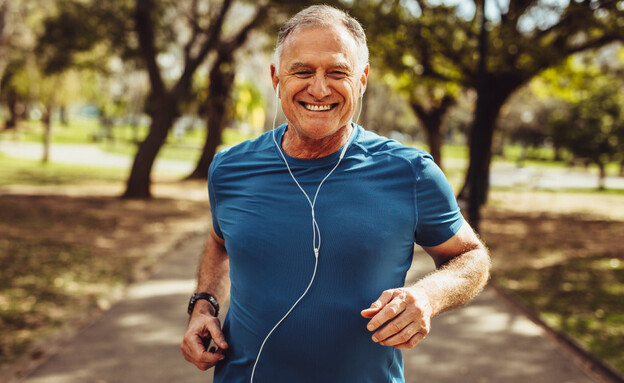How does physical activity affect anxiety?
 [ad_1]
[ad_1]

In general, any physical activity is recommended to reduce stress and anxiety compared to sitting still. Aerobic training such as: walking, running, swimming, cycling and dancing; More recommended than strength training and even known to have a protective and long-term effect against anxiety symptoms. Aerobic training causes the release of endorphins, serotonin, dopamine and other neurotransmitters that contribute to a sense of calm, improved mood and energy and vitality over time. In a recent study involving 200,000 participants, it was found that vigorous aerobic activity significantly reduced the risk of anxiety symptoms compared to low-intensity activity. The good news was that even at a lower intensity, a positive effect was found for physical activity on symptoms of anxiety in both women and men.
The practical recommendation: Persist in aerobic activity at a high or low heart rate at least once – twice a week to gain the “vaccination” effect against stress and anxiety symptoms over time.
Two are better than one
One of the most helpful factors in reducing the feeling of anxiety is emotional support. Studies show that going for a walk or a run together with a close person increases the relaxing effect of physical activity, and creates more motivation to exercise over time. For those who experience anxiety attacks, feeling motivated is an essential commodity, so the joint training may have a double and multiplied effect. Among other things, this finding is explained by the distraction that exists when someone else is with us during the activity, as well as by a higher sense of commitment that we feel to a joint process.
The practical recommendation: Offer a person close to you to join you for training regularly.
Get out
Nature has a healing, strengthening and relaxing effect and staying in it is known as a natural remedy against stress and anxiety. A study conducted in 2021 in Europe found that during the Corona period, physical activity in nature became an important means for the general population to deal with emotional and social difficulties, including an increase in stress and anxiety levels. Combining nature with exercise is one of the most recommended ways to reduce the risk of anxiety attacks over time.
The practical recommendation: Take advantage of the healing powers of nature to move and soothe the feelings of stress and everyday annoyances.
Combine exercise with therapy or emotional counseling
Clinical studies show that the combination of emotional therapy and physical activity is a winning combination. A study that examined the effects of physical activity on anxiety symptoms found that the combination of psychotherapy and physical activity was more effective than emotional therapy alone in reducing stress. Physical activity serves as a “catalyst” of emotional therapy and it can speed up the emotional processes embodied in conversations in the emotional therapy process alone.
The practical recommendation: Combine physical training with talk therapy and you will get a comprehensive and better answer to the anxiety problem.
Join the group
Although social distance and individuality have already become prominent signs of the 21st century and have a significant part in the increase in anxiety symptoms, it is still important to remember that sleepwalkers are social creatures by nature. Perhaps this is the reason why physical training groups have been found to have a significant advantage in reducing feelings of stress and anxiety. Training in a group gives a feeling of empowerment and motivation due to the sense of common belonging. However – not every group training will be able to benefit you. Studies indicate the importance of choosing a group that suits you in terms of characteristics and size. Groups that are too small or too large may not provide the same effect as a medium group where we won’t stand out too much but won’t be “swallowed up” either. In addition, it is important to find a group in which physical characteristics are similar such as: age, ability and physical structure. A group where we feel like we don’t fit in can create more stress than benefit us.
The practical recommendation: Choose a group that suits you in terms of the size and style of the group members and allow yourself to receive the empowering and anxiety-relieving powers of group and strengthening physical activity.
Go exercise in the morning
did you know The early morning hours have a calming and strengthening effect on the body and mind. This is a time when the world is quiet, most people are still asleep and there are no honking cars or congestion on the roads, the air is also still clean and there are fewer distractions. A study conducted in 2019 that compared the effects of morning training to evening training indicated a more significant effect of the training on reducing anger, stress, and improving the mood and mental well-being of the participants in the morning group compared to the evening training group. These conditions increase the positive effect of physical training on stress and anxiety symptoms. By the way, if you don’t define yourself as a “morning type” – don’t worry: a new study revealed that in order to maintain motivation and the immunizing effect of training against stress it is important to stick to training at a fixed time – in the morning or in the evening.
The practical recommendation: Take advantage of the early hours of the morning for a particularly relaxing workout. If the morning is less for you, choose a time that suits you better and stick to it.
Put the phone aside
In the age of technology and multi-tasking, many people go out to exercise and continue to work and the mobile is an integral part of the exercise process. However, it is important to note that being in front of the screen and busying yourself with work while training does not allow the stress-reducing benefits of physical training to be fully realized, given the decrease in physical and mental investment directed at training. A study that compared the speed and heart rate of participants while walking on a treadmill with the use of a cell phone compared to training without it, showed that the participants produced a higher physical benefit from the exercise that was manifested in choosing a higher speed and a higher heart rate – when they did not use the cell phone. At the same time, when the use of the cell phone was for listening to music only, there were no differences between the groups. At the same time, it is worth noting that using a cell phone during training increases the risk of injuries, which may cause more stress later on.
The practical recommendation: Try to put the mobile aside or on “flight mode”, and focus only on the physical training and the good feeling you get through it.
It’s not the quantity – it’s the quality
So how long should you train to get the stress and anxiety reducing effect from physical training? Well, the World Health Organizations recommend 150 minutes a week of moderate-intensity exercise. The recommendation is to combine aerobic training with strength and flexibility training. At the same time, various studies have shown that even one 20-minute workout may improve feelings of anxiety and produce calm over time. Moreover, a study that examined the effects of moderate running on the risk of heart disease and endurance, which are linked to stress and anxiety among 55,000 adults over 15 years; found that even people who were less active than recommended by health organizations and included in their lives only 5 minutes of daily running, significantly reduced the risk of mortality, especially in heart disease; Compared to people who were not active at all.
The practical recommendation: Remember that even a short workout is better than nothing.
In conclusion: a feeling of anxiety may undermine our self-confidence and lead to distress. Even when it’s hard and it seems that all is lost – there is always something to do and most of the answers are found in the body. Learning, awareness of movement and appropriate physical activity along with receiving appropriate emotional assistance if necessary, may give you life skills to deal with stress and anxiety.
The author, Dr. Hila Sharon-David, is a certified psychologist, develops the Gufregesh method for personal empowerment through physical activity, an expert in behavioral change processes and a doctor in sports psychology and physical training www.gufregesh.com[ad_2] https://g3box.org/news/world/how-does-physical-activity-affect-anxiety/?feed_id=9119&_unique_id=631ef3785e874


0 comments:
Post a Comment